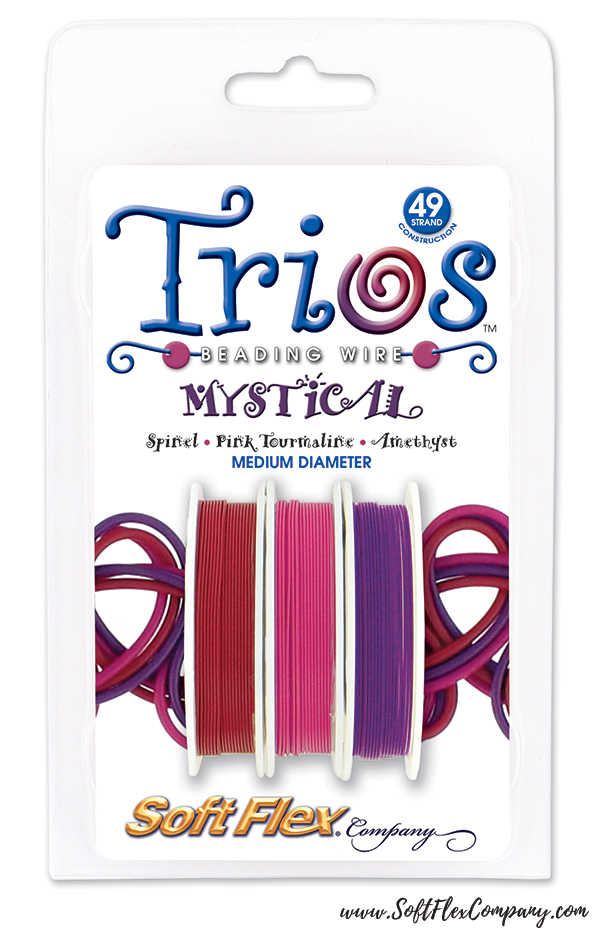Let's look at the color wheel. How can we use it to make our jewelry come alive? Today, we will look at analogous and complementary colors. Analogous colors sit adjacent to each other on the wheel. Complementary colors are directly opposite on the wheel. This quick read will show you how to pair your analogous colors with paired complements. Your beaded projects will be rousing and magical.
We love Margie Deeb's intimate knowledge of colors and we wanted to re-share some of our archive articles she has written for us. Margie is an incredibly talented artist, designer, and author. Follow along on her color journey. Let's all become students of color!
Apply color theory to your next design with Trios Beading Wire Packs. Trios Multi-Color Beading Wire is a lead-free beading wire for designers that want to create jewelry with color mixing in mind. Trios Color Wire Sets encapsulate the vivid palette of nature and the glamour of the fashion world. Trios Color Wire Sets are comprised of three 10 foot spools of Soft Flex Beading Wire, the wire is constructed of 49 micro woven stainless steel wires. Explore analogous and complementary color combinations with Trios!
Below, Margie discusses how to use analogous and complementary colors to create magical jewelry designs. Learn how to use the spectrum of a color wheel to your advantage.
Excerpt from The Beader's Guide to Color
Something happens when you pair the enchantment of adjacent colors with the gusto of complements... something rousing and vigorous, coursing with life. This "something" is technically called the analogous complementary scheme. But what really happens is magic.
Begin this magic by choosing an analogous group of two or three colors adjacent to each other on the wheel - okay, four if you must! This group becomes the dominant color force.
For the complementary part of this alchemy, select the color directly across from the middle of the analogous group. This direct complement becomes the accent color. Or, choose a near-complement (one on either side of the direct complement).
You have now created a dominant color grouping of three similar colors accented with the direct complement (or the near-complement) of one of them. See the color wheel below
"Waning Crescent".
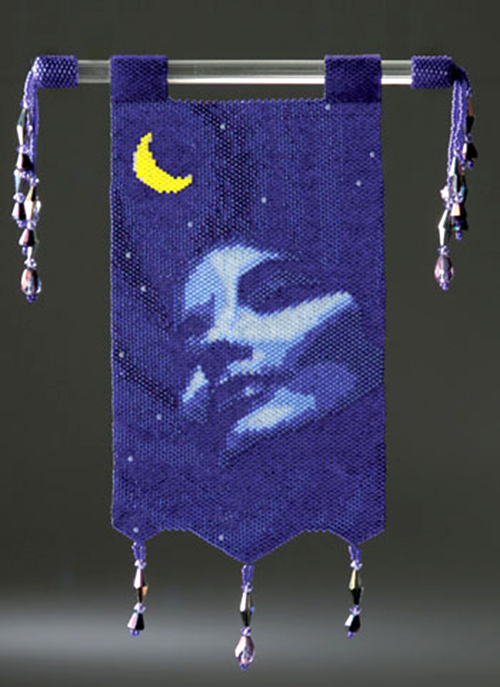
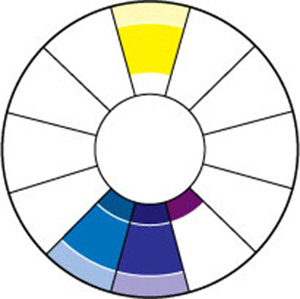
"Waning Crescent" by Margie Deeb exemplifies the analogous complementary scheme. Tranquil blues
play the dominant role, emphasizing the meditative reverie of the night drenched dreamer.
One complementary accent–moonlight yellow–commands our attention.
Tapestry created by Frieda Bates in peyote stitch.
Pattern available in
The Beader's Guide to Color
Got it? Good! That was "Analogous Complementary Magic 101."
To graduate to "202," switch the dominant color to feature its complement rather than one of the analogous members. Mingle accents of the analogous colors into the dominant background made of the complementary color.
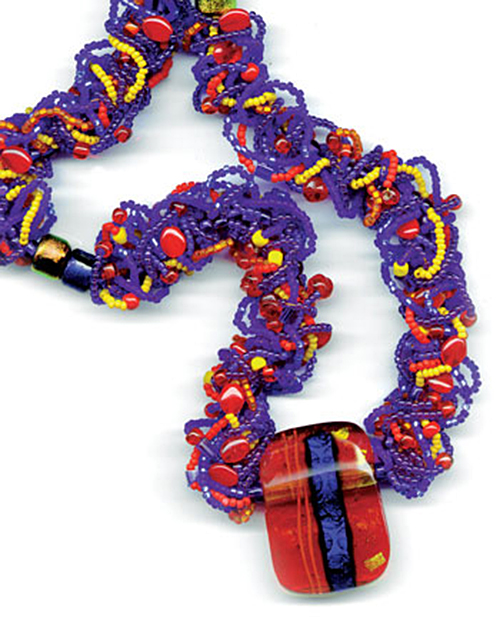
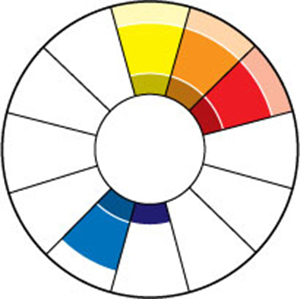
A show-stopping combination of brilliant, irresistible colors comprise this
startling analogous complementary scheme.
Necklace by Margie Deeb based on a technique by Diane Fitzgerald.
In the necklace and accompanying color wheel above, the blue sits directly across the wheel from the orange of the yellow-orange analogous group. It could have been used as an accent color, with startling results. But instead, blue was used as the main color. The results are equally stunning.
To practice "Analogous Complementary Magic 303," extend the palette. Rather than using just one complementary color, put two or three to work. See "Chanin Study" (below).
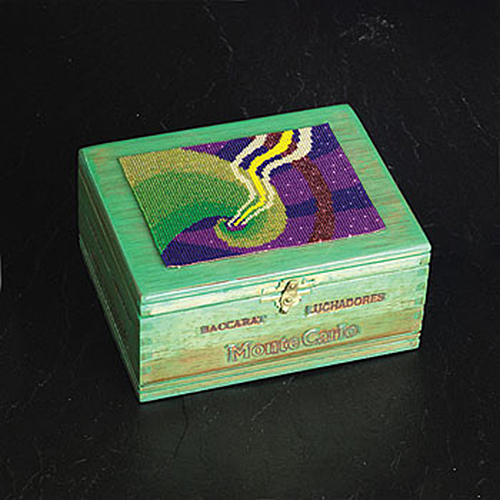
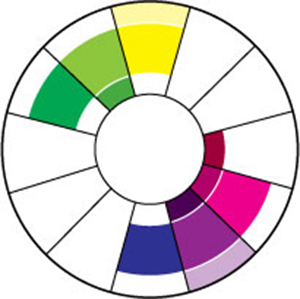
An extended, complex interpretation of the analogous complementary scheme.
"Chanin Study" by Margie Deeb (created by Frieda Bates) was inspired by the abstract
Art Deco ornamentation on the Chanin Building in New York.
Avoid a random mish-mash of colors, logical relationships have been established. The analogous members are grouped together: violet, purple and red serve as a background, greens and yellows swirl and flow in front.
An extended analogous complementary scheme is as complex to work with as it is to say aloud. Juggling these many colors, especially complements, requires planning.
But it is worth every effort. What happens when you harmonize and balance this lively array of color? Pure magic!
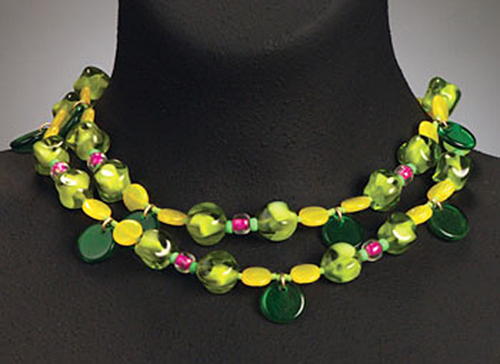
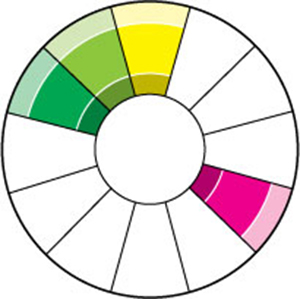
Accents of magenta among the green-to-yellow analogous group are an
unexpected surprise, pulsing this scheme to life.
Necklace by Margie Deeb.
Join our Facebook group – VIB. Stay in the know. Stay up to date. From our bead shows to our video shows and sales, you can stay in touch with us. The community is full of artistic and helpful beaders and crafty people. Inspire and be inspired. Share your pictures and get the beading bug from others!
Visit the Soft Flex Company YouTube Channel!

Artist and color expert Margie Deeb is the author of The Beader's Color Palette, The Beader's Guide to Color, The Beader's Guide to Jewelry Design and numerous beading and color publications. She teaches color and beading across the country and her free monthly color column, Margie's Muse, is available on her website. She writes regularly for Beadwork, Bead & Button, and Step-by-Step Beads magazines.
Visit Margie's website for her books, kits, patterns, jewelry, inspiration, and more: www.MargieDeeb.com



